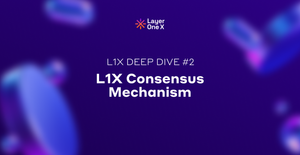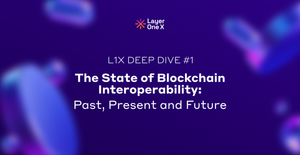Welcome to Episode IV of our L1X Deep Dive Series, where we unravel the intricacies of Block Rewards and Tx fee structure, with the experts, Kevin Coutinho and Dr. Neeraj Khairwal.
In this session, we're not just scratching the surface – we're delving deep into the nitty-gritty details that drive the heartbeat of decentralized networks. From the exhilarating pace of non-fungible token (NFT) testing and resolution within 24 hours to the intricate dance of fee structures across networks like Squid Router, XLR Network, Layer Zero, and X Stock, we're leaving no stone unturned.
So grab your seat and let's explore the ins and outs of fee calculation strategies, and a peek into the future of interoperability with X-Talk. Let's dive in!
WATCH FULL AMA
Section 1. Exploring Block Rewards and Transaction Fees in Cryptocurrency Networks
In this section, Kevin starts providing an update about the XPerks Club and Nodes NFT. The session will cover Transaction fee structure, block rewards, fee calculation strategies, and hands-on comparison with different Networks like Squid Router, Axelar Network, Layer Zero and X-Talk.
It highlights the importance of creating a modular fee structure. From the developer's standpoint, there are two points of view: projects built on L1X and projects built somewhere else that use X-Talk for interoperability.
Section 2. Fee Structures and Event Listening Triggers: A Comparative Analysis Across X-Talk, Chainlink and Layer Zero
X-Talk has two types of fees: 1. You register for an event source (how often do you listen to this information. That's the trigger). 2. Something called Action (is sending the payload)
L1X VM has two types of fees: 1. When doing contract deployment. 2 When you do State Changing calls (update on the blockchain). You have also Event logs and Pure read-only calls that do not have the fees necessarily
Kevin goes through the X-Talk fee structure and explains the fee structure of other Networks like Chainlink and Layer Zero to analyze the differential point.
It also compares how X-Talk, Chainlink, and Layer Zero handle event listening triggers. With X-Talk allows for easy object creation and event naming, Chainlink requires the setup of service workers and Oracle nodes, and Layer Zero necessitates compatibility with its contract standards.
Each network has its own method: X-Talk offers flexibility in listening frequency, Chainlink relies on service workers and Oracle nodes, and Layer Zero requires adherence to its contract standards for compatibility.
Section 3. Decentralized Contract Updates: Insights into Layer Zero's Architecture and Fee Structure
Kevin focuses on the process of updating contracts and registries in a decentralized system, specifically on Layer Zero contracts. When updating the global registry, the information is sent to a Full Validator Node (FVN), which then communicates with an Oracle node to ensure deterministic updates. The X-Talk Node listens to this information and triggers actions based on filters set in the X-Talk node. This can send information to the extra contract for further processing. An upkeep contract is used to listen to information from a Chainlink node and send it to the desired contract. In Layer Zero, the executor contract is responsible for receiving information from an Oracle node and sending it to the appropriate contract. The fees associated with these actions are discussed, with Layer Zero having specific fees such as a blockchain fee, security stack fee, and executor fee. It is emphasized that having a streamlined architecture can help reduce costs associated with multiple contract executions.
Section 4. Understanding Transaction Fees: Prioritization, Configuration, and Fairness in Network Operations
Kevin talks about the importance of transaction fees in the context of security and network congestion. It is explained that the fee structure is designed to prioritize certain transactions based on their value and impact on the network. Kevin also touches upon the configuration required for security settings and the complexity of fee calculation. He mentions the different types of fees, such as initial source blockchain fees and execution fees, and how they are paid in native coins. Additionally, it highlights the concept of deterministic fee models for various transaction types, including transfers, deploying contracts, and staking. The goal is to create a fair and predictable fee system to support different business models and transactions on the platform.
Section 5. Decoding Contract Execution Fees: Understanding Deterministic Models and Cost Efficiency in L1X EVM
Kevin discusses the calculation of contract execution fees in EVM, specifically focusing on cross-contract calls and the determinants of fees based on gas or units consumed. It explains the concept of deterministic fees, storage resources, and the correlation between units consumed and op codes. The transcript also mentions constant fees for certain operations like transfers and staking, as well as system-level libraries such as cryptographic hashes with constant fees based on instruction groups.
He emphasizes the cost-effectiveness of L1X EVM compared to other platforms like Avalanche or Arbitrum, highlighting the flexibility and future-proofing capabilities of L1X EVM. Additionally, he also touches on grant programs and interoperability restrictions imposed by some layer one projects, contrasting them with the more open approach of L1X EVM. The fee model is presented as crucial for attracting developers and ensuring the sustainability of transactions and business models.
Section 6. Exploring Near Protocol: Leveraging L1X EVM, Future-Proof Contracts, and Network Scalability
Kevin discusses the features of Near Protocol, including the ability to write contracts using L1X EVM, future-proofing contracts with L1X VM and X-Talk infrastructure, and changing database types. He mentions the importance of fee structure and future-proofing.
Dr. Neeraj then discusses the impact of block and transaction size on network scalability and throughput, as well as the configuration of time units for coordinated network activities. The time units include slots, chunks, epochs, and cubes, with each unit representing a specific duration for block creation and network activities.
Section 7. Configuring Consensus and Transaction Tokenomics: Understanding Time Units and Transaction Categories
Dr. Neeraj discusses the time units needed for configuring consensus mechanisms and block production, as well as selecting validators and coordinating network activities. She then moves on to transaction tokenomics, focusing on transaction categories such as native transactions, EVM transactions, and intro transactions within a single block.
She explains how transaction size is estimated in bytes and how the total size is calculated based on the number of transactions. The total size is less than 5 MB, which is the block size considered. She also talks about transaction costs, including validation, invocation, computation, storage, address, and memory costs, with validation and invocation costs being burned and the rest returned as rewards.
The concept of one L1X being equal to 10^9 nlx (Nano L1X) is detailed and explains how transaction fees are calculated and represented in l1x units. She mentions a base fee and a speed-up factor for transactions and discusses how burning fees and network fees are proportional.
The conversation also goes on to talk about transaction details such as transaction size, invocation units, storage read/write requirements, and address access units for different transaction types.
Section 8. Decoding Transaction Costs: Exploring Components and Economics Across Networks
Dr. Neeraj discusses the various components and costs involved in a transaction on a network. It covers aspects such as memory access, validation quotient, global quotient (equivalent to gas units in the Ethereum network), invocation cost, computation cost, storage cost, address quotient, and memory quotient.
The costs are calculated based on factors like the number of bytes accessed, types of transactions initiated, network bandwidth, and memory usage. Different validations are necessary for any transaction submitted to the network, and charges may vary based on the specific requirements of the transaction.
She emphasizes the importance of understanding these cost components in driving transaction economics.
Section 9. Adaptable Opcode Tables and Future Initiatives: Enhancing Protocol Flexibility and Security
Kevin discusses the modular structure of the opcode table in the protocol, allowing for updates to op codes and cost adjustments based on functions built into the protocol.
He mentions the benefits for applications building with L1X.
He also touch on future plans for username NFTs and revenue sharing, as well as the involvement of mobile validators in fee sharing. The speaker explains that node operators cannot set their own fees but can set fee limits, and discusses finding a balance between transaction fees and interests. Lastly, they talk about the security of FN and ELN nodes, emphasizing various security aspects to consider.
Community Questions
Q: What is the relationship between Username NFTs and transaction fees and what would a Username NFT earn?
A: We are working with Omchain on Digital identity solutions, where there is a proposition there for usernames.
Anything that goes through the L1X App (swaps, gaming, etc), it will be shared as a form of revenue to the Usernames NFT.
There's also going to be an L1X Marketplace where users will be able to sell their Usernames and Node NFTs.
Q: Will the future mobile validator get a share of the ELN or FVN pool?
A: At the current moment, the ELNs have their own mechanism for how the trigger cost can be established and also how the action cost can be established, but at the same time, the action cost is shared with the FVN.
When the mobile nodes are introduced, they will act as a super-block register, and if the FVN and ELN have their own way of setting up their transaction fees up to an extent, they will both be a participant in sharing that fee with the mobile node.
A transaction going through as a ledger, ELN has also a database and even that will have a way in the coming time to index, as to which ELN will go for that type of information, so they will both be sharing it.
Watch this question
Q: Can Node operators set their node fee and which parameters would be considered to set it?
A: No, you can't set up your node fee. You can set a fee limit.
If the users are trying to pay the fees, they have to set a fee limit, like 1,000 nlx coins. If that is the fee limit there, you could set 5,000, so any transaction less than that wouldn't come through, but you can't say that when the transaction comes to me, I'm going to set my own fee on top of that.
Watch this question
Q: Is it good for node operators that would receive less fee reward, how do you find the best balance between the different interest?
Look at the maximum number of transactions going through on the protocol. In any other protocol if you see the majority of them are like stable coin transfers that occupy the majority of them. In our case, if the token standard has a deterministic fee model.
There is a hard cap in terms of how many transactions can be processed. You don't only have to rely on transaction fees, there's always the block rewards as well as the proposal. Right now it's randomly done, so everyone gets an opportunity to propose a block and get the block fees.
Watch this question
Q: How secure is the new structure of the FVN and the ELN?
A: There are various pointers, like State-changing behaviours, like someone can fork it and go and produce their own blocks or the connection between ELN to FVN structures. At each and every place are these cryptographic algorithms that are placed to re-verify if you are the owner or you have permission to actually call them.
Also at the Smart contract level, there are those security features. Hashlock has been auditing the SC, but when it comes to the consensus, the cryptographic way of doing this is derived from the past Bitcoin.
Only mobile validators are where we have to be more careful, but this layer of security will be introduced later on.
Watch this question
Q: Is it possible to create Meme Coins on L1X directly after TGE?
A: Yes, interoperable Meme Coins
Watch this question
Q: How is the money in transaction fees distributed?
A: 50% is going to the FVN, another % goes to ELN and the remaining goes to the Foundation and/or some of them is getting burnt.
Since the Block rewards are pretty high (one of the highest in the market), it will increase the tx fees towards the FVN and ELN and reduce the block validator nodes after some time. We are taking the risk of burning those coins and not putting it on the node hosting people, so they have a deterministic fee model initially.
Watch this question
Q: To create a token in L1X what are the major criteria and benefits one gets in terms of node sustainability?
A: Initially you have your hosting, so you will be hosting your FVN and ELN. FVN automatically decides and will be able to feature Shard it and automatically decides. On the ELN side, you will be able to configure pricing based on who wants to register what kind of information with you.
Watch this section
Did you miss the L1X Deep Dive Episode I. The State of Interoperability: The Past, the Present and Future? Read the Summary Now.
Did you miss the L1X Deep Dive Episode II. L1X Consensus Mechanism? Read the Summary Now.
Did you miss the L1X Deep Dive Episode III. L1X Virtual Machine? Read the Summary Now
Stay updated on Discord and in our Social Media Channels so you don't miss any important News.







